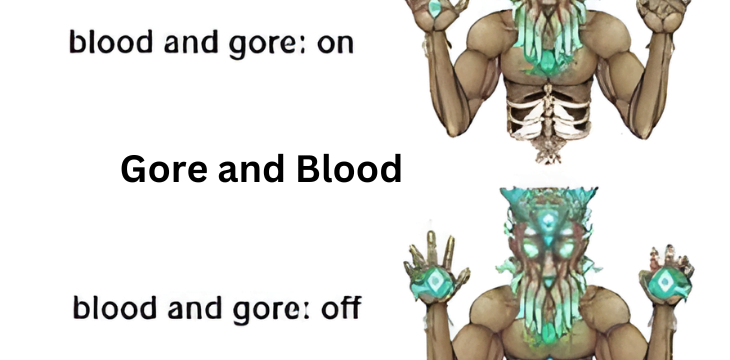Dive into the world of gore and blood as we explore the intricacies, significance, and impact of these elements in various contexts.
Table Of Contents
Introduction
Gore and blood have long fascinated and repelled humanity in equal measure. From the visceral scenes in horror movies to the stark realities of medical emergencies, these elements evoke strong emotions and provoke intense reactions. In this comprehensive guide, we delve deep into the realm of gore and blood’s, exploring their cultural, psychological, and physiological significance.
The Essence of Gore and Blood
Understanding gore and blood
Gore, often associated with graphic violence, encompasses depictions of bodily harm, mutilation, and extreme brutality. It serves as a potent tool in storytelling, invoking fear, shock, and discomfort.
Exploring gore and blood
Blood, the life force coursing through our veins, holds symbolic and physiological significance. Beyond its vital role in oxygen transportation, blood symbolizes life, death, and the essence of humanity.
The Psychology of Horror gore and blood
Impact on the Human Psyche
Gore and blood elicit primal responses rooted in our evolutionary history. The sight of blood triggers the ‘fight or flight’ response, activating regions of the brain associated with fear and survival instincts.
Desensitization and Sensitization
Repeated exposure to gore and blood can desensitize individuals, reducing their emotional response over time. Conversely, prolonged exposure may heighten sensitivity, leading to increased distress and anxiety.
Cultural Perspectives
Historical Context
Throughout history, gore and blood have played integral roles in cultural rituals, religious ceremonies, and artistic expressions. From ancient sacrificial rites to Renaissance paintings, these elements reflect societal beliefs and values.
Contemporary Representations
In today’s media-saturated world, gore and blood permeate various forms of entertainment, from movies and video games to literature and art. Their portrayal often sparks debates about censorship, artistic freedom, and ethical boundaries.
Medical Implications gore and blood
Trauma and Treatment
In medical settings, gore and blood’s are everyday realities, encountered by healthcare professionals in emergencies and surgical procedures. Understanding their physiological effects is crucial for effective trauma management and patient care.
Blood Disorders and Diseases
Beyond trauma, blood disorders and diseases pose significant health challenges worldwide. Conditions such as hemophilia, leukemia, and HIV/AIDS underscore the importance of blood-related research and medical advancements.
Ethical Considerations
Consent and Boundaries gore and blood
The depiction of gore and blood raises ethical concerns regarding consent, particularly in media production and artistic representation. Respecting individuals’ boundaries and sensitivities is paramount in creating responsible content.
Impact on Vulnerable Populations
Certain demographics, such as children and individuals with trauma-related disorders, may be particularly vulnerable to the effects of graphic imagery. Implementing age restrictions and content warnings can mitigate potential harm.
Addressing Common Misconceptions
Myth: Gore and Blood Desensitize Society
Contrary to popular belief, research suggests that exposure to gore and blood’s does not inherently desensitize individuals. Context, personal experiences, and individual differences play significant roles in shaping emotional responses.
Myth: Graphic Content Causes Violence
While media violence has been a subject of debate, studies have failed to establish a direct causal link between exposure to gore and blood in media and real-life aggression. Social and environmental factors exert far greater influence.
FAQs (Frequently Asked Questions)
- What is the psychological impact of gore and blood’s exposure?
- Exposure to gore and blood’s can evoke fear, anxiety, and desensitization, depending on individual differences and contextual factors.
- Are there age restrictions for consuming media with graphic content?
- Many jurisdictions enforce age restrictions for accessing content featuring gore and blood’s, aiming to protect children and vulnerable populations.
- How do healthcare professionals manage trauma involving gore and blood’s?
- Healthcare professionals undergo rigorous training to effectively manage trauma cases, prioritizing patient care and safety.
- Can exposure to graphic content in media lead to real-life violence?
- While media violence is a complex issue, research has not conclusively proven a direct causal link between media exposure and violent behavior.
- What ethical considerations surround the depiction of gore and blood’s in media?
- Ethical considerations include obtaining consent, respecting boundaries, and minimizing harm, particularly for vulnerable audiences.
- How can individuals cope with distress triggered by graphic imagery?
- Practicing self-care, seeking support from trusted individuals, and engaging in healthy coping mechanisms can help manage distress related to graphic imagery.
Conclusion
In conclusion, gore and blood are multifaceted phenomena with profound implications for individuals, societies, and cultures. By exploring their psychological, cultural, and medical dimensions, we gain insights into the complexities of human nature and the enduring allure of the macabre.


